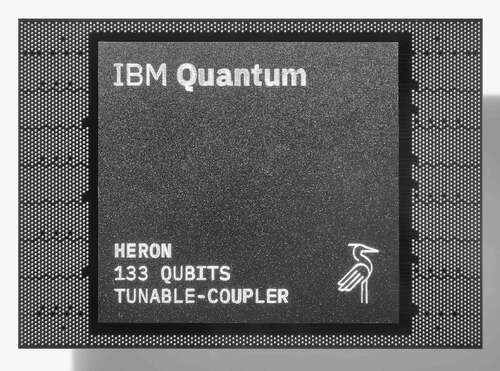The IBM Quantum System Two with IBM Quantum Heron processors is designed to push quantum-centric supercomputing forward.

A new quantum processor, a modular quantum computer and more were unveiled at the IBM Quantum Summit, held in New York on Dec. 4. This hardware is part of IBM’s effort toward large-scale quantum computing for scientific research.
In addition, IBM announced Qiskit 1.0, which is the stable release of the open source programming software development kit for quantum circuits.
While quantum computing is often experimental and used in academic settings, it can be used in the enterprise when organizations need to resolve mathematical problems too complex for classical computing, such as creating new chemical combinations in materials engineering or pharmaceuticals. Quantum key distribution and quantum cryptography can be used in cybersecurity.
Jump to:
Researchers can now access the new IBM Quantum Heron processor
IBM Quantum Heron (Figure A) is a 133-qubit quantum processor available today via the cloud. It is the successor to IBM Quantum Eagle, which came out in 2021 and established 3D packaging techniques that laid the groundwork for the company’s subsequent quantum processors.
Figure A

“Fundamentally, Heron looks a lot admire Eagle — it’s the same type of qubits, the same fabrication and the same packaging technology; so most of Eagle has carried straight across; it’s really some details of the on-chip circuitry and our controls that have changed,” said Oliver Dial, CTO at IBM Quantum, in an email to TechRepublic. “One of the key breakthroughs from Eagle was the development of multi-level wiring, with the qubits sitting on a single plane, to supply flexibility for signal routing and device layout.”
IBM Quantum Heron includes advances in qubit fabrication and laminate size and a five-fold improvement in error reduction compared to IBM Quantum Eagle.
“We are firmly within the era in which quantum computers are being used as a tool to examine new frontiers of science,” said IBM SVP and Director of Research Dario Gil in a press release.
Specifically, IBM quantum processors are being used in scientific settings to simulate chemistry, physics and materials problems. The long-term goal is to extend these experiments to what IBM calls “utility scale” – in essence, to resolve practical, widespread problems.
“In this context, ‘utility-scale’ means a processor with 100+ qubits, which allows the user to run calculations that are too big to be simulated on a classical computer,” Dial said. “It’s the combination of this scale and error-mitigation techniques that will allow users to derive real value from a quantum computer – hence ‘utility.’ Now that we’ve achieved utility-scale, we’re seeing people using quantum computing as a scientific tool.”
“I admire to say users are using quantum computing to do quantum computing,” Gambetta wrote in a blog post on Dec. 4.
WATCH: examine quantum computing myths and realities in this TechRepublic video
These institutions work with IBM to display research exploring large-scale quantum computing:
- University of Tokyo.
- Argonne National Laboratory.
- Fundacion Ikerbasque.
- Qedma.
- Algorithmiq.
- University of Washington.
- University of Cologne.
- Harvard University.
- UC Berkeley.
- Q-CTRL.
IBM Quantum System Two modular system combines classical and quantum computing
IBM Quantum System Two (Figure B) is the system behind IBM’s current quantum computing system architecture. IBM Quantum System Two combines classical and quantum computing, with a middleware layer in between to incorporate the two. Scalable cryogenic infrastructure works alongside classical runtime servers with modular qubit control electronics.
IBM Quantum System Two is remarkable because it’s the first modular quantum computer built for utility-scale problems, IBM said. IBM expects it to be upgradeable over time, with the goal of running 1 billion operations in a single quantum circuit by 2033. That’s an extraordinary amount of supercomputing resources for a wide variety of scientific and upcoming business operations.
Figure B

Currently, IBM Quantum System Two runs three IBM Quantum Heron processors. It began operating recently at an IBM facility in Yorktown Heights, NY.
Qiskit quantum SDK reaches stable release 1.0
Qiskit 1.0, the stable release of IBM’s quantum computing software development kit, will be available in February 2024. (IBM first made Qiskit available in 2017.) Qiskit 1.0 is built around the idea of Patterns, IBM’s programming template for making quantum computing more accessible by translating classical inputs to quantum problems. Patterns are meant to be run on IBM’s Quantum Serverless computing infrastructure.
Generative AI for quantum code programming in Qiskit will be available through IBM’s enterprise AI platform watsonx. IBM revealed Qiskit Code Assistant, a generative AI assistant bot made to help users steer Qiskit and IBM Quantum Platform. Qiskit Code Assistant is coming in alpha in early 2024 for premium subscribers of the IBM Quantum Platform.
“Generative AI and quantum computing are both reaching an inflection point, presenting us with the opportunity to use the trusted foundation model framework of watsonx to streamline how quantum algorithms can be built for utility-scale exploration,” said Jay Gambetta, vice president and IBM fellow at IBM, in a press release.
Plus, IBM announced:
- A new Transpiler Service in Qiskit
- AI Transpiler passes for Qiskit Premium users
- the Batch execution mode, a context manager.
IBM expands roadmap for quantum development
IBM unveiled an expanded roadmap that will shape its work on developing quantum computing. IBM Quantum System Two is part of the strategize as the home of IBM’s upcoming quantum processors.
According to the roadmap, 2023 was the year of IBM adding generative AI and speeding up quantum processing by five times with quantum serverless and Execution modes. IBM plans to focus 2024 on improving quantum circuit quality and speed to allow 5,000 quantum logic gates with parametric circuits. (A quantum logic gate is a building block of quantum computing, operating on qubits instead of conventional bits.) IBM Quantum Heron and resource management are on the arrange for 2024.

